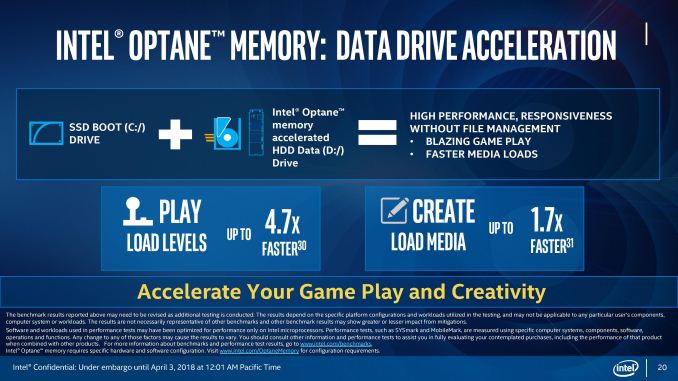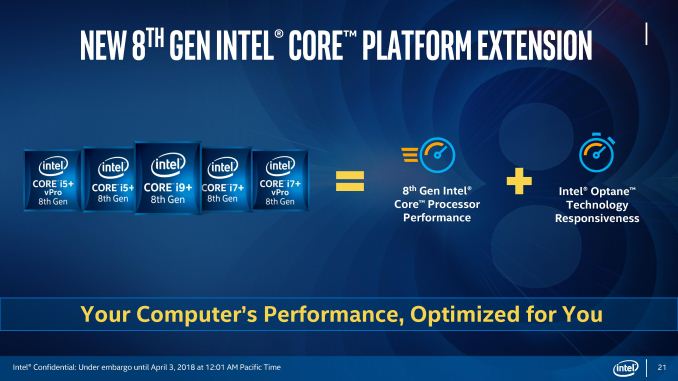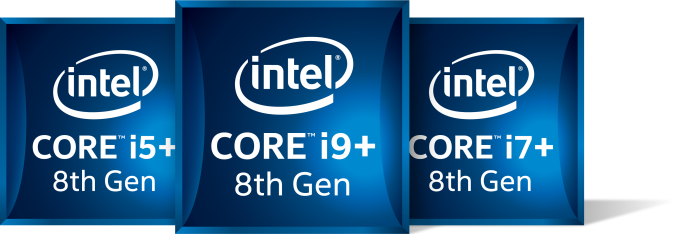Intel Expands 8th Gen Core: Core i9 on Mobile, Iris Plus, Desktop, Chipsets, and vPro
by Ian Cutress on April 3, 2018 3:01 AM ESTNew Optane Branding
Core i9+, Core i7+, Core i5+
One of the items that Intel is keen to promote with this launch is an update to its Intel RST algorithm when dealing with ‘Optane Memory’, Intel’s brand for Optane whereby a small amount of storage is placed in front of a larger drive to act as a fast cache. Up to this point, Intel platforms that supported Optane Memory in this configuration could only do so on the drive that was used to boot into the operating system. While this worked well for low-cost users that relied on a single rotational hard-disk drive of rust for their needs, with most enthusiasts using a fast SSD (SATA or PCIe) as their first drive that loads the OS, putting Optane Memory in front of this as a cache was relatively pointless – any gains would be intangible at best. With the new generation of products, Intel has expanded the capabilities of Optane Memory such that it can act as a cache for a non-OS drive. This means that a user can have a fast SSD boot drive, a large spinning drive for storage, and then place Optane in front of that storage drive to potentially get much better performance from the drive.
The main idea here is that the large rotational drive is where users store games and large files used in content creation, which often have a long loading time. With the right caching algorithm, and a decent sized Optane Memory drive, Intel likes to promote that loading games and loading media for creative purposes are several factors faster than an equivalent system without an Optane Memory drive.
Part of the news around Optane is that Intel is now creating new processor branding for OEMs that have configurations with Optane. The new brands and logos are similar to the standard Core i5/i7 style that we are used to, however the logos are now a dark blue with white text, and exhibit a plus after the Core i5/i7 name.
So just to be clear, this is not a new line of processors. We will not have to suddenly deal with a Core i9+-8950HK being different to the non-plus counterpart. This is purely a branding exercise, and one that only covers the i5 and higher at that. However, to complicate things, this means that specification sheets can (and will) list the processors as Core i5+ and Core i7+ and even vPro models. This makes looking for particular processor versions in search engines a lot more difficult for almost no obvious benefit. I mean sure, Intel wants to promote the use of its Optane drives, but we already have the Optane branding and the Optane logos to do that for us. This ends up being another logo put onto the box.
Ultimately, Intel is still marketing Optane, its high-cost R&D product, with low capacities at low cost systems with relatively little margin. While it might seem like a noble goal, to bring extra caching performance down to the lower cost segment, it could very easily be done with SATA or PCIe M.2 drives using regular NAND flash. A lot of users would like to see high-capacity, high-endurance Optane drives moving more into the mainstream, instead of more attempts at funneling in a product like Optane into caching.













123 Comments
View All Comments
close - Tuesday, April 3, 2018 - link
Intel's "mobile" branding was always a clusterfuuu. They just relied on the reputation the desktop parts had and used the same branding and very similar model numbers to sell castrated CPUs with lower core count and much lower frequency that delivered nothing like the desktop ones.satai - Tuesday, April 3, 2018 - link
@close - how can anybody with a basic knowledge of HW expect, that a 15W part is going to perform similary to a 90W one?Ratman6161 - Tuesday, April 3, 2018 - link
Because they have no idea that one is 15W and the other is 90W. The other thing they have no clue about is that in my experience most mobile cpu;s are going to spend very little time at the advertised turbo speed. They will start thermal throttling almost instantlyclose - Wednesday, April 4, 2018 - link
@satai, so you mean the millions of people who go to a store or a website and buy a laptop know that it uses a 15W CPU and not a 65 or 95W CPU? Is this a joke?Most people hear about Intel or i7 and then go for the laptop that has that. And Intel capitalizes on the
close - Wednesday, April 4, 2018 - link
*Crappy 1997 comment system.Intel capitalizes on the confusion this creates. And it takes more than basic HW knowledge. Most people don't spend their days on tech websites. You would probably make the same mistakes in a field you're not familiar with.
HStewart - Tuesday, April 3, 2018 - link
These statements are confusing, everything here stated that the mobile 6 core CPU's do have Hyperthreading. 6C/12TMarketing wise - AMD does similar tactics calling Ryzen 7, Ryzen 3 .... maybe they will have Ryzen 9 one day.
Ratman6161 - Tuesday, April 3, 2018 - link
AMD is at least a little better on this. Generally speaking the 3/5/7 distinctions hold up...with potentially confusing exceptions of course.HStewart - Wednesday, April 4, 2018 - link
My first computer was an AND composed marking cup- at the time I thought I was getting an Intel 386 25mhz chip and they put Amd clone 25mhz chip. I spent $1700 and that was cheep thenSonic01 - Tuesday, April 3, 2018 - link
Still no Core Y / 4.5W updates... its been 2 years now :/jhoff80 - Tuesday, April 3, 2018 - link
I'm guessing that they're skipping to Cannon Lake / 10nm for the Y-series, but who knows.